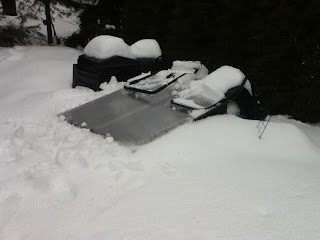By request, I am compiling my organic lawn care recommendations in one place and starting a WormMainea YouTube channel.
In this video I show how to core aerate with the Yard Butler*
In this video I demonstrate overspreading compost
I also took a soil sample from the yard to see whether I am getting close to my target organic matter level and whether need to do anything else (calcium, etc.). I took a composite sample from 15 areas (5 front yard, 5 side yard, and 5 back yard). These approximately equal small samples were mixed in my soil tub and then placed in the box.
Here are links to some of my earlier blogs related to lawn care
http://www.wormmainea.blogspot.com/2010/04/natural-lawn-care-preparing-and-timing.html
http://www.wormmainea.blogspot.com/2011/04/integrated-pest-management.html
http://www.wormmainea.blogspot.com/2010/09/how-well-does-organic-lawn-care-work.html
http://www.wormmainea.blogspot.com/2010/04/thoughts-on-weeds.html
*The Yard Butler D-6C Core Lawn Aerator is great for established lawns or lawns where a lot of activity takes place. Core aeration reduces compaction and thatch to let air, water and fertilizer down to the root zone. Core aeration also stimulates root growth by “pruning” the roots and deposits valuable micro-organisms on the lawn surface. I find this tool a lot easier to use than the gas-powered beast I rented from Home Depot a few years ago. And, because I have it available, I can use it to aerate compacted areas when someone drives on the lawn.
In this video I show how to core aerate with the Yard Butler*
In this video I demonstrate overspreading compost
I also took a soil sample from the yard to see whether I am getting close to my target organic matter level and whether need to do anything else (calcium, etc.). I took a composite sample from 15 areas (5 front yard, 5 side yard, and 5 back yard). These approximately equal small samples were mixed in my soil tub and then placed in the box.
 |
| Collecting a soil sample for the University of Maine Cooperative Extension Soil Test |
Here are links to some of my earlier blogs related to lawn care
http://www.wormmainea.blogspot.com/2010/04/natural-lawn-care-preparing-and-timing.html
http://www.wormmainea.blogspot.com/2011/04/integrated-pest-management.html
http://www.wormmainea.blogspot.com/2010/09/how-well-does-organic-lawn-care-work.html
http://www.wormmainea.blogspot.com/2010/04/thoughts-on-weeds.html
*The Yard Butler D-6C Core Lawn Aerator is great for established lawns or lawns where a lot of activity takes place. Core aeration reduces compaction and thatch to let air, water and fertilizer down to the root zone. Core aeration also stimulates root growth by “pruning” the roots and deposits valuable micro-organisms on the lawn surface. I find this tool a lot easier to use than the gas-powered beast I rented from Home Depot a few years ago. And, because I have it available, I can use it to aerate compacted areas when someone drives on the lawn.







